Should accountants build custom GPTs? 8 real-life examples to get you thinking.

Isaac Perdomo
Co-Founder, Opzer.co
Automation expert, Isaac Perdomo, shares 8 ways accountants can use Open AI's custom GPTs.

If you've been trying to make sense of OpenAI’s ChatGPT feature releases, you’re not alone.
With each new option, it gets trickier to decide which features are most useful for your accounting firm.
Fear not. In this article, I’ll be discussing:
The difference between plugins, the assistant API, and custom GPTs
The anatomy of a custom GPT (and what makes it special)
Custom GPT examples and ideas
Let's start by breaking down the different AI (Artificial Intelligence) capabilities built by OpenAI, and their best use cases.
Plugins vs. GPTs vs. assistant API: What’s the difference?
Regular ChatGPT needs no detailed explanation. It’s the chat-based AI assistant that everyone has been talking about (and you’ve probably used).
But what about all of the other versions and add-ons available?
Here are the differences and some key definitions:
Plugins simply add an extra capability to ChatGPT 4’s interface. These are powered by a third-party service built by developers. Popular examples include AskYourPDF or DocMaker.
Assistant API (Application Program Interface), on the other hand, does not live within the chat. Instead, it’s used to integrate OpenAI capabilities into your existing apps and workflows via code (or low-code solutions like Zapier).
Custom GPTs, just like ChatGPT, are AI assistants, but built with a specialized need in mind. They sit somewhere between the generalized solution ChatGPT offers by default and the fully-custom solutions a developer can build with the API.
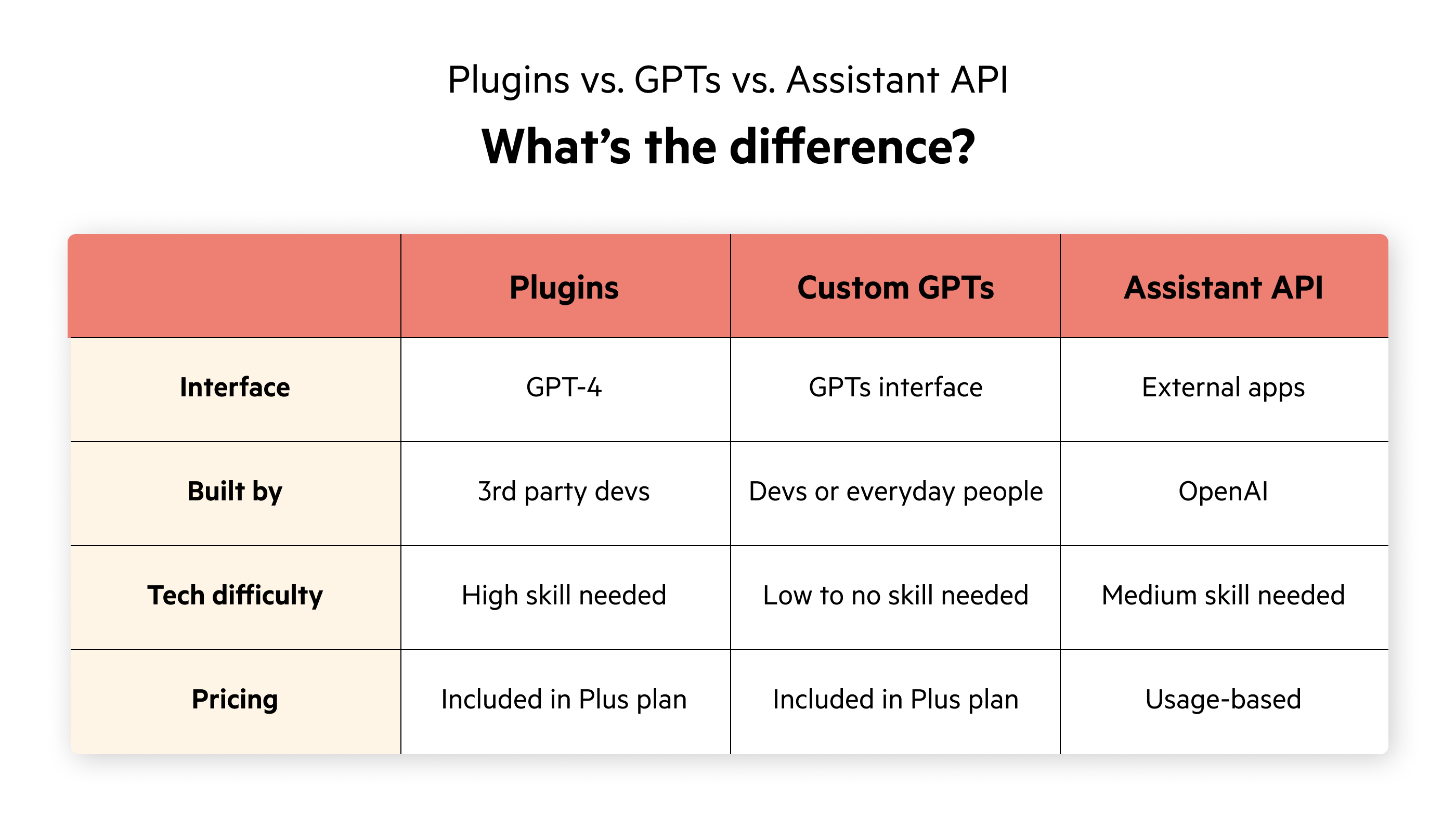
It’s also worth noting: there’s overlap between plugins and the most public custom GPTs.
Many of the same companies who developed plugins quickly created public GPTs with similar functions.
What makes custom GPTs special?
Although using public custom GPTs is helpful, building your own poses some unique benefits.
You can:
Build it to your own requirements
Update it easily via a chat interface
Provide your own set of knowledge and data
Grant access exclusively to your team (under the Open AI Teams plan)
As an automation firm, at Opzer, we find it particularly interesting that you can connect your GPTs to low-code automation platforms like Zapier or Make.com, turning the GPT into an agent that can take action on your behalf.
These low-code platforms become your ‘authorization hub’ to safely provide access to QuickBooks, Karbon, or any other app you've connected.
Knowing this about custom GPTs, let’s break apart the important pieces that make it up.
The anatomy of a custom GPT
To truly understand how a custom GPT works, we need to look at its main components:
Instructions (The ‘Fixed Prompt’)
Knowledge (The ‘Brain’)
Actions (The ‘Hands’)
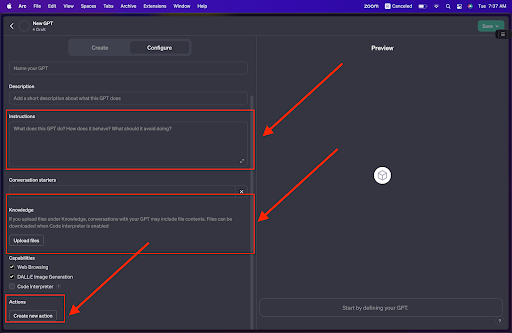
Instructions (The 'Fixed Prompt')
The backbone of a custom GPT is its main prompt.
In a regular ChatGPT chat, you might find yourself repeating your query several times.
The 'Instructions' area acts as a fixed prompt that guides the AI to interpret your queries and respond in the way you specify so you don’t have to re-write your request.
Knowledge (The 'Brain')
By default, users don’t really have access to the sources ChatGPT is trained on.
It’s impressive—no doubt—but what if you wanted to provide specific tax laws, financial regulations, or accounting principles? Or even specific knowledge on how your firm operates?
That’s where the 'Knowledge' area comes in. It allows regular people to provide relevant, personalized context to the AI assistant.
This is done by uploading a file—be it a .PDF, .TXT, or otherwise—for the GPT to reference specifically.
Actions (The 'Hands')
The real power of a custom GPT is its ability to take action.
That said, learning to connect the ‘Actions’ feature does require some technical knowledge.
Through direct API calls or integrations with low-code platforms like Zapier or Make.com, a custom GPT can trigger workflows and automate tasks across various applications.
For instance, it could look for information in a spreadsheet, database, or even your accounting software.
It could also automatically send emails to clients, Slack messages to your team, or update records on your behalf.
Crazy.
Let’s look at several examples.
8 custom GPT examples to get you thinking
For each GPT idea, I'll outline:
The knowledge you could provide to the GPT
Potential actions to automate
A link to an existing public GPT that's similar, along with an example result from a prompt
A note on data privacy:
Providing and protecting data remains one of the biggest challenges of making AI useful. That’s outside the scope of this article.
Consider leaving GPTs private to you and your company, ensuring the model is not trained on your data, and anonymizing sensitive information.
1. Tax advisor GPT
Purpose: Serve as a tax advisor, identifying tax-savings strategies relevant to your business and clients while ensuring tax compliance.
Knowledge to provide: Up-to-date tax laws and regulations, client-specific financial situations.
Actions to automate: Validate tax strategies, ensure compliance, identify potential savings, and answer specific tax-related queries given a situation.
Similar public GPT: Marc Howard from Taxplow built one of the first TaxAdvisor GPTs in the space. Also, the team at Think Accounting created a GPT specifically for Canadian taxes.
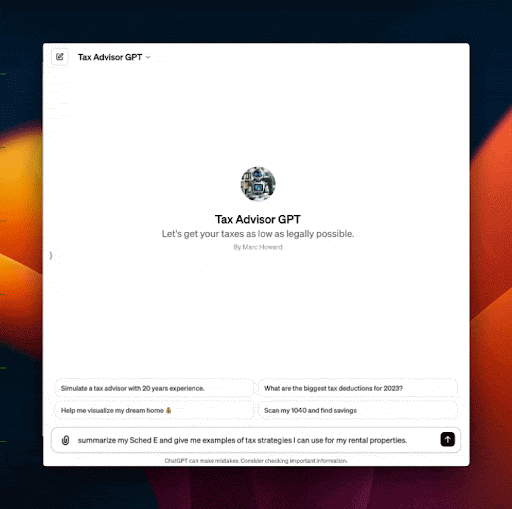
2. Financial statements GPT
Purpose: Allow clients or team members to get insights and ask questions about financial statements data.
Knowledge to provide: For a more advanced setting, you might connect the GPT to QuickBooks Online’s API to gather financial data in real-time.
A simpler setting is to allow people to upload their anonymized statements—or create individualized GPTs with the financial data provided in the ‘Knowledge’ section.
Actions to automate: Interpret financial reports, offer summaries including trends and anomalies, and answer specific questions about your clients’ financial statements.
Similar public GPT: Jason Staats published a Financial Statements GPT, prompting accountants to deliver financials with an AI assistant clients can chat with.
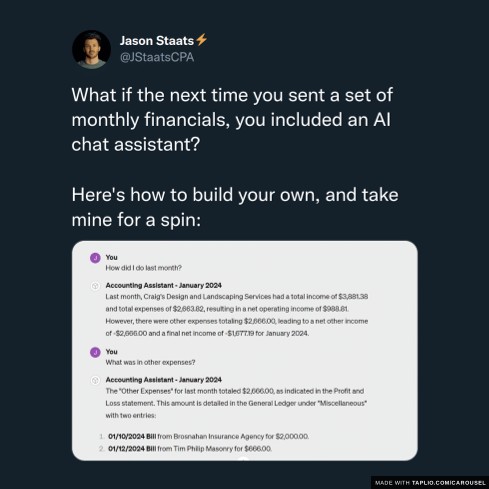
3. Reconciliation GPT
Purpose: To help bookkeepers more easily deliver accurate data and identify ledger mistakes and discrepancies.
Knowledge to provide: Anonymized financial data like detailed transaction records, bank statements, and accounting ledgers.
A more complex setup would be to connect it to direct sources—like bank feed software, accounting software, etc.—to access up-to-date transaction data.
Actions to automate: Automatically match transactions, highlight discrepancies between records, suggest corrective actions for mismatches, and generate reconciliation reports.
Similar public GPT: I found this Reconcile Helper GPT. Not exactly the concept I envisioned, but close.

4. SEO content GPT
Purpose: Write articles that rank on Google and readers enjoy.
Knowledge to provide: SEO best practices, keyword research data.
You might provide updated SEO guidelines—as well as keyword rankings and content performance data—to improve the model over time.
Actions to automate: Create SEO-optimized content outlines, draft articles, and suggest improvements to existing content for better SEO performance.
Similar public GPT: Jacob McMillen, an SEO writer, created LongForm Blog Cyborg GPT. The assistant is instructed to create an outline and write an article one section at a time.
Hint: I drafted this blog post using it (it took many more edits, I should admit).
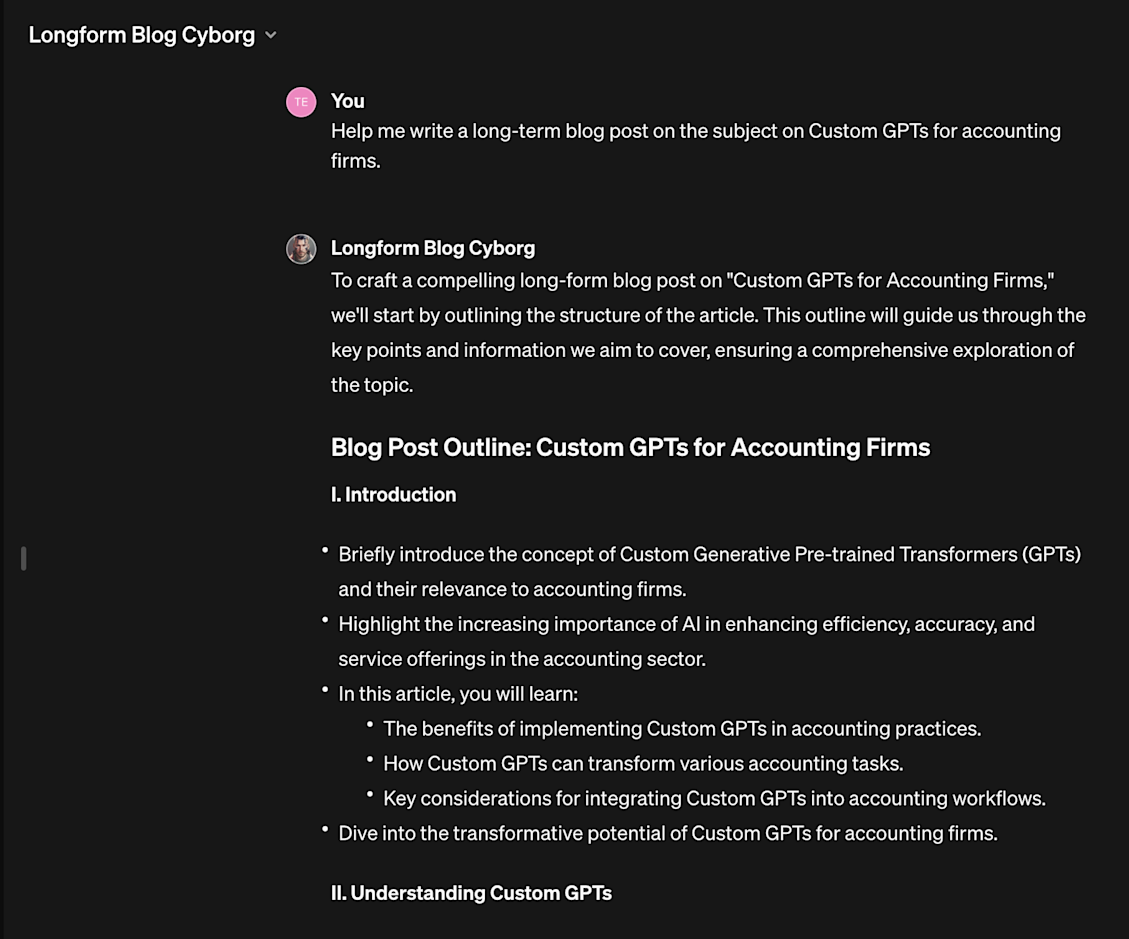
5. Video Content GPT
Purpose: Quickly create video outlines, scripts, and content for social media.
Knowledge to provide: Your own guidelines on video content creation and engagement best practices for the major video platforms.
Actions to automate: Generate video scripts and outlines, create B-roll, suggest titles, thumbnails, and descriptions. Publish content on your behalf.
Similar public GPT: The team at Veed created Video GPT based on its own tool. I prompted it to create a short-form video on 'accounting automation’.
Its subtitles didn’t make much sense, the B-roll wasn’t relevant, but it’s a starting point that I can further edit from within their app.
6. Process documentation GPT
Purpose: Automate the creation of detailed process maps and procedures.
Knowledge to provide: Existing process documentation and transcripts of workflow recordings.
Actions to automate: Generate visual process maps and text-based procedures, identify bottlenecks or inefficiencies, and suggest optimizations.
Similar public GPT: Whimsical, a popular diagramming tool, has a GPT available in the store.
I asked it to 'create a high-level process map of a tax return filing workflow’. Here’s what it came up with:
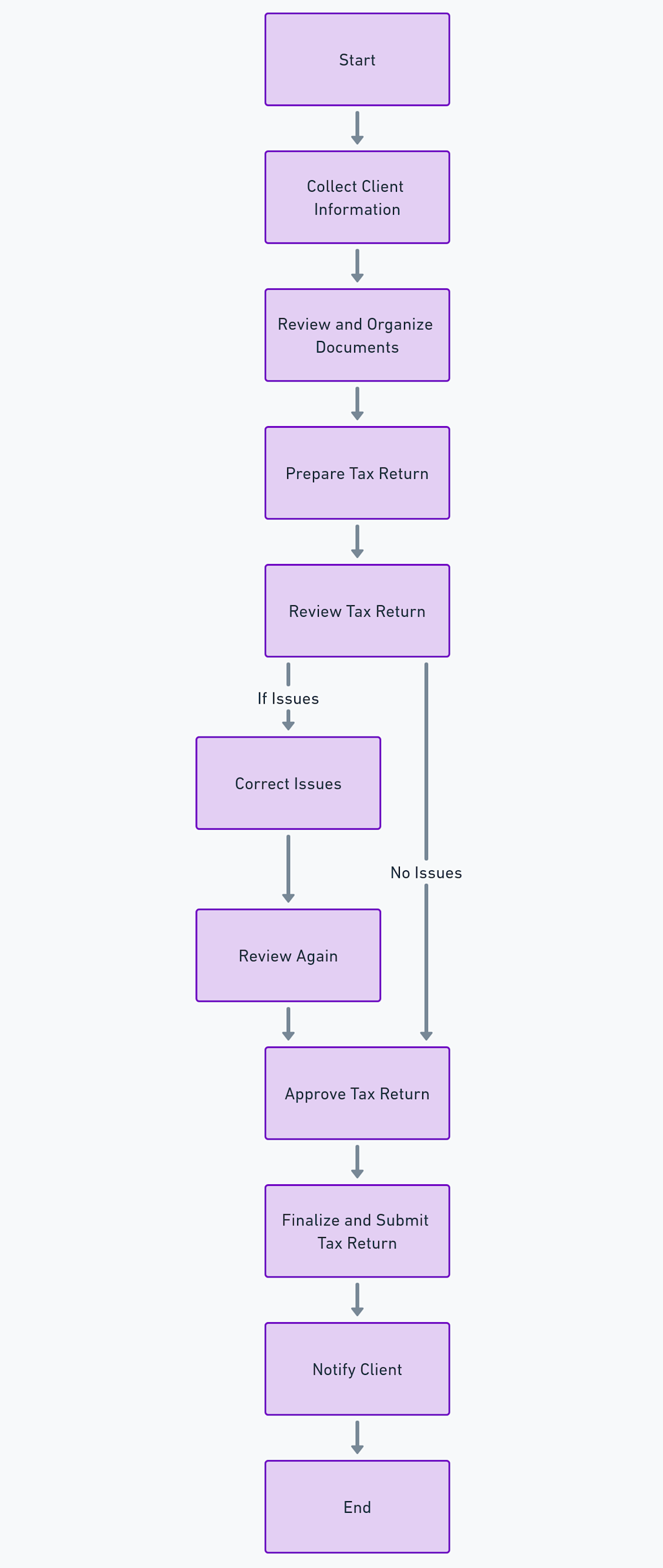
Similarly, professionals like David Boese, owner of PriorityTax.ca and Future Firm community member, developed custom GPTs to help him quickly write procedures in case you favor a written format.
7. Team onboarding GPT
Purpose: Enable new employees to ramp up faster by asking any questions about your company processes and policies.
Knowledge to provide: All company manuals, SOPs, and policies.
For a more advanced setting, you might integrate the assistant with your knowledge base directly, or even your CRM (Client Relationship Management) software to extract client interactions.
Actions to automate: Respond to queries from new employees, navigate them through company SOPs, and familiarize them with client backgrounds and history.
Similar public GPT: Not surprisingly, I didn’t find a GPT like this. This data is often guarded, so it’s a better fit for a private assistant that only internal teams have access to.
That said, Brian Clare from Blueprint Accounting commented he built a 'Blueprints Knowledge' (connected to his Notion’s knowledge base) for this exact purpose.
8. Recruiting assistant GPT
Purpose: Find your next team member faster by creating descriptions, assessing resumes, and identifying the best candidates.
Knowledge to provide: Provide existing job descriptions, resumes, applicant details, and interview transcripts.
You could connect this GPT with a database (e.g., Airtable) for real-time updates as new applicants apply and are interviewed.
Actions to automate: Rank candidates according to job requirements, confirm the suitability of shortlisted candidates, draft job descriptions, and come up with targeted interview questions.
Similar public GPT: Take a look at Recruit GPT. I asked it to rank four candidates for a technical role. It wasn’t that far off from my own assessment.
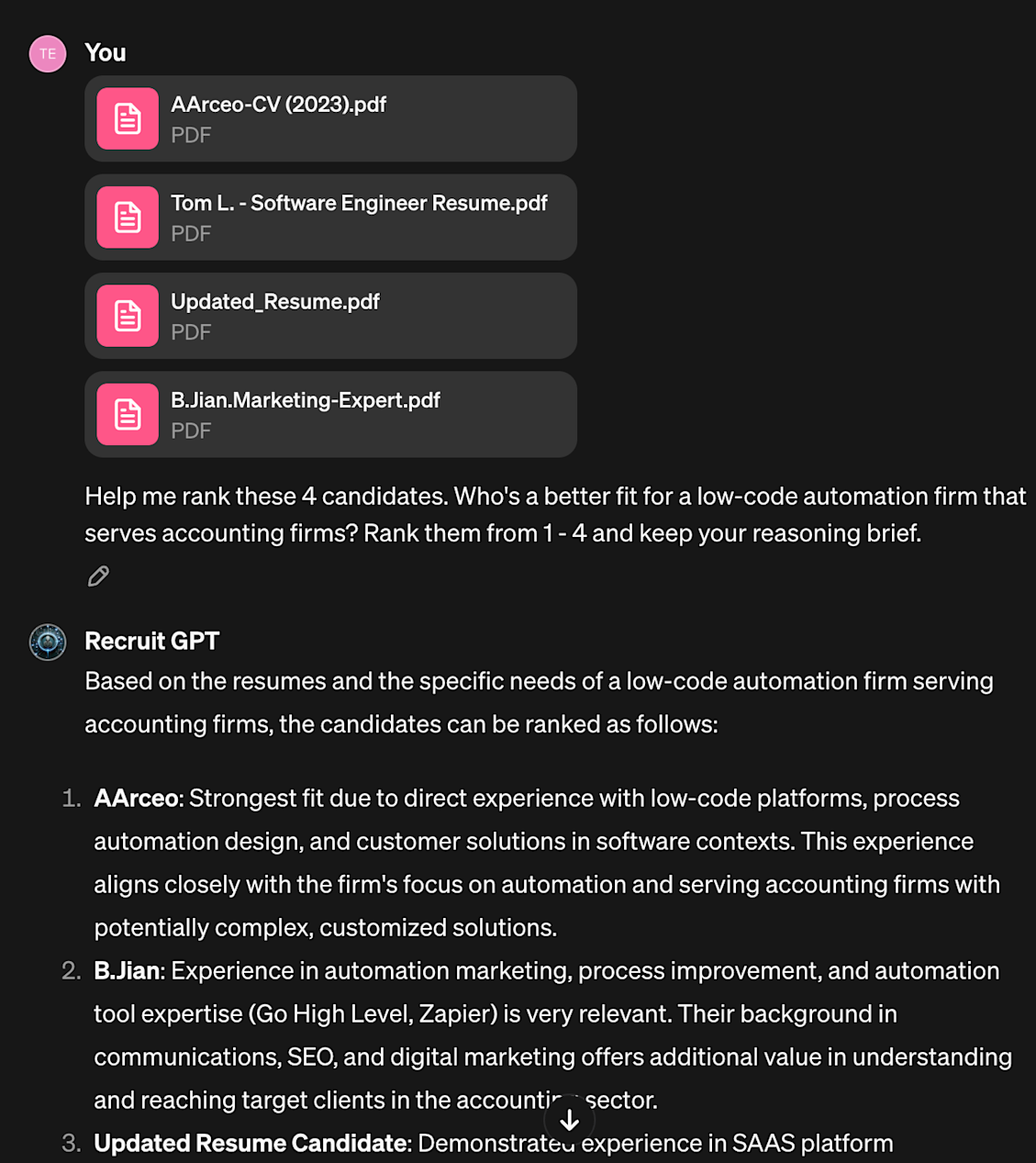
GPTs will continue to specialize
As time goes on, we’ll see more specialization in the AI space. Custom GPTs is one step in that direction.
It's likely software companies will integrate these functionalities into their products.
In the meantime, creating your own custom GPT can ensure you’re always one step ahead.
Take the examples above and start taking baby steps.
With low-code and AI, automation is getting more accessible by the day.